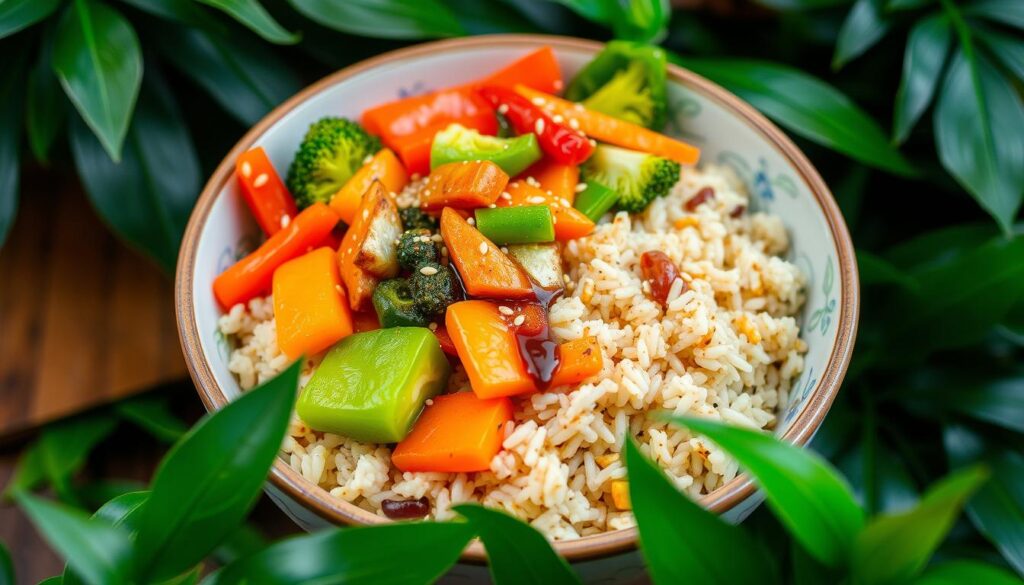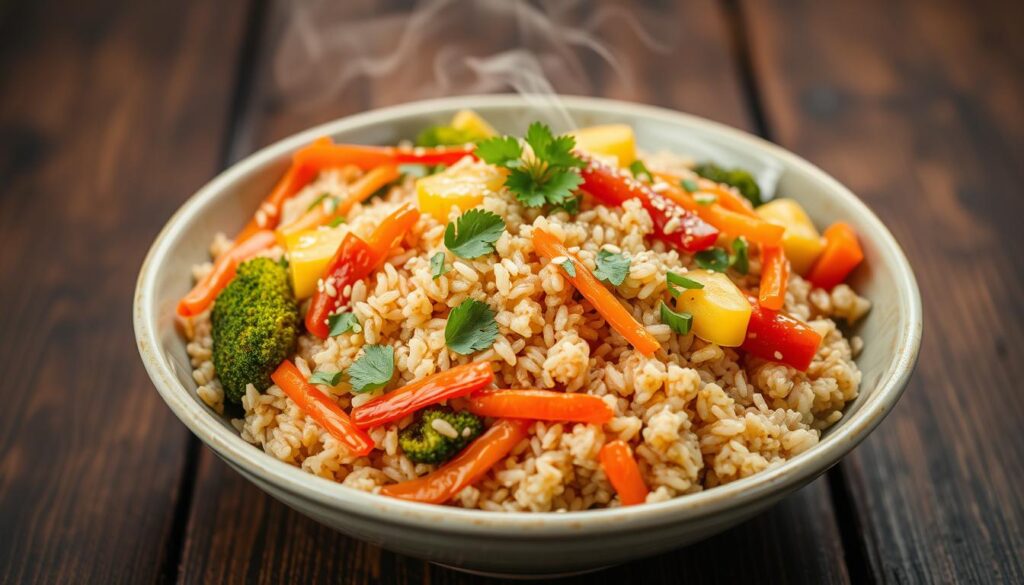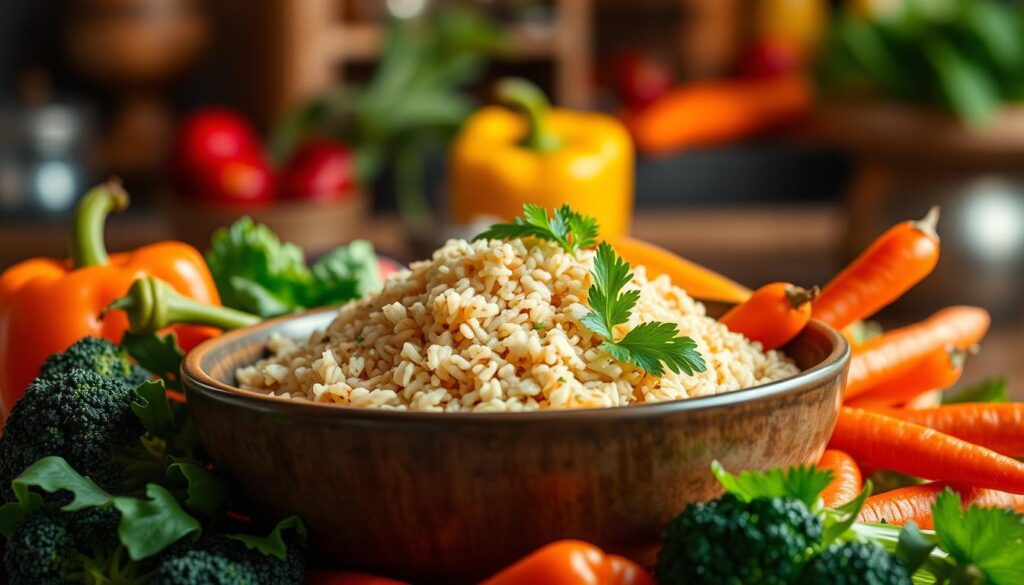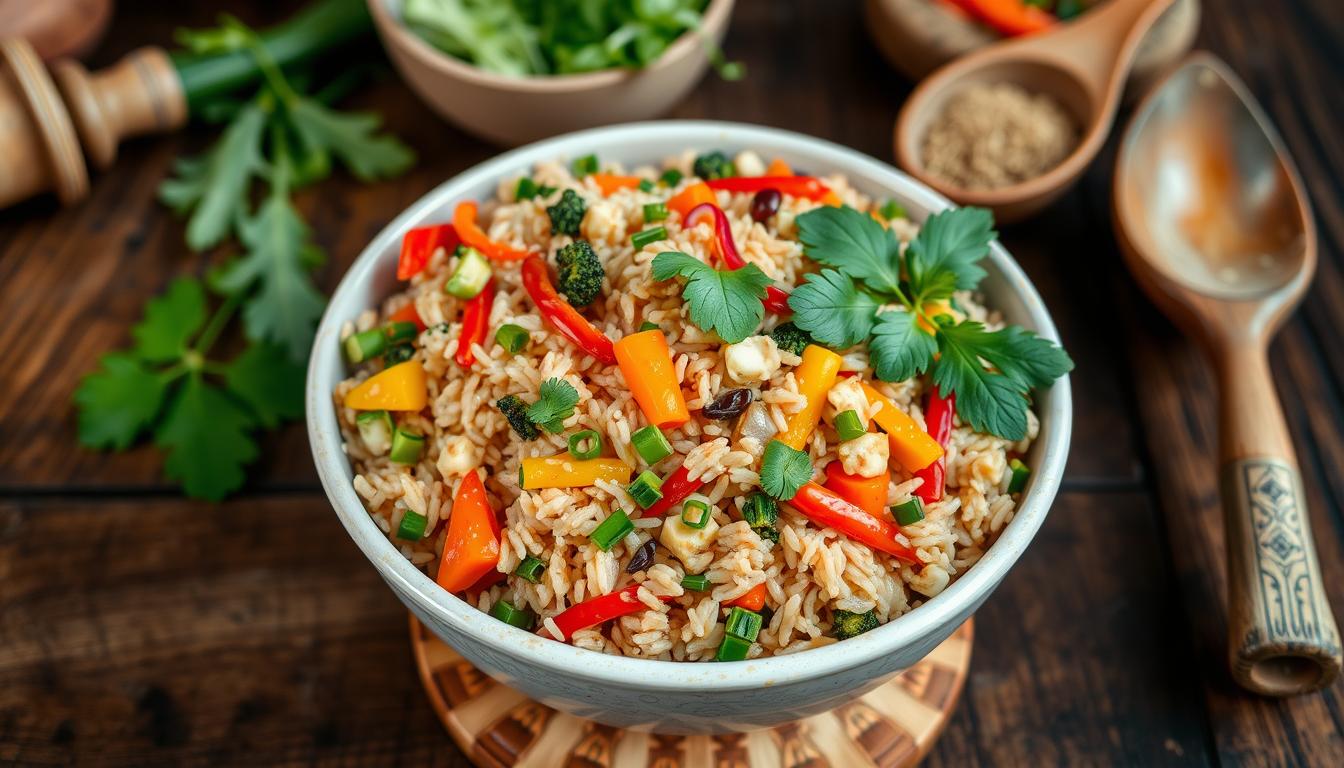Imagine a dish that takes you to Southeast Asia’s heart. This brown rice with vegetables recipe is more than food. It’s a celebration of tradition, health, and the region’s rich culinary heritage. It’s filled with fresh, aromatic ingredients and bold flavors.
As you eat, the smells of ginger, garlic, and soy sauce remind you of night markets and family gatherings. The colorful vegetables, like bell peppers and bok choy, are not just pretty. They’re also packed with nutrients. This recipe shows the wisdom of Southeast Asian cuisine, where every part is chosen to nourish and please.
Table of Contents
Introduction to Southeast Asian Cuisine and Its Influence
Explore the vibrant flavors and rich culture of Southeast Asian cuisine. It comes from countries like Thailand, Vietnam, and Malaysia. This cooking tradition is known for fresh ingredients, aromatic herbs, and balanced tastes.
From fragrant rice dishes to flavorful Asian meals, it has won hearts around the world. Its unique southeast asian flavors stand out.
Understanding Traditional Cooking Methods
Southeast Asian cuisine uses traditional cooking methods like stir-frying, steaming, and boiling. These methods keep the natural taste and nutrients of ingredients. Stir-frying, for example, uses high heat to enhance flavors and keep vegetables and proteins fresh.
The Role of Rice in Southeast Asian Culture
Rice is a key food in Southeast Asian culture. It ranges from fragrant jasmine rice to earthy brown varieties. This grain is the base for many healthy rice bowls.
Rice’s importance goes beyond food. It holds cultural and spiritual value in the region’s traditions and celebrations.
Health Benefits of Southeast Asian Cooking
Southeast Asian cuisine focuses on fresh, whole ingredients and nutrient-preserving techniques. It offers a lot of plant-based dishes like stir-fried vegetables and aromatic curries. These, along with healthy rice bowls, show the region’s commitment to well-being and balanced nutrition.

“Southeast Asian cuisine is a symphony of flavors, where the interplay of sweet, sour, salty, and spicy notes creates a truly memorable dining experience.”
Essential Ingredients and Kitchen Tools
To make a tasty Southeast Asian brown rice dish, you need fresh, tasty ingredients and the right tools. You’ll want to use crisp veggies like bok choy, bell peppers, broccoli, and carrots. The brown rice you pick is also important, with choices like long-grain, medium-grain, or short-grain.
For cooking, a wok or large skillet is best for stir-frying veggies and mixing them with brown rice. You’ll need sharp knives for chopping veggies. A rice cooker or strong pot helps cook the brown rice just right. If you care about health, choose organic or non-GMO ingredients for better nutrition.
| Ingredient | Description |
|---|---|
| Brown Rice | Choose from long-grain, medium-grain, or short-grain varieties |
| Vegetables | Bok choy, bell peppers, broccoli, carrots, and more |
| Herbs and Spices | Lemongrass, kaffir lime leaf, betel leaf, laksa leaf, mint, shallot, galangal, torch ginger, Thai basil, fresh turmeric |
| Cooking Tools | Wok or large skillet, sharp knives, rice cooker or pot |
Choosing the right ingredients and tools lets you make a delicious brown rice veggie stir-fry. It’s a dish that highlights the bright flavors of Southeast Asian cooking.

Benefits of Choosing Brown Rice Over White Rice
Brown rice is a top pick for nutritious rice bowls and healthy dishes. It keeps its outer layers, packed with nutrients. This makes it a better choice than white rice.
Nutritional Comparison
Brown rice is full of fiber, vitamins, and minerals. These are lost when white rice is refined. It has more magnesium, calcium, and selenium. These help with bone health, blood sugar, and heart disease.
Cooking Time and Texture Differences
Brown rice cooks a bit longer than white rice. It tastes nuttier and has a chewier texture. This longer cooking time helps keep more nutrients and fiber.
Health Advantages of Brown Rice
- Lower glycemic index, which helps regulate blood sugar and supports weight management
- Higher in antioxidants, such as phytic acid and polyphenols, that protect against chronic diseases
- Richer in magnesium, a mineral crucial for heart, bone, and muscle health
- Excellent source of dietary fiber, promoting digestive health and cholesterol reduction
Adding more nutritious rice bowls and healthy rice dishes with brown rice boosts your nutrition. It supports your overall health and well-being.

Southeast Asia Brown Rice with Vegetables Recipe
Explore the lively tastes of Southeast Asia with this brown rice and vegetable dish. Brown rice is a healthier choice than white rice and is key in many Asian dishes. It pairs well with fresh veggies, making a dish that’s both balanced and tasty.
Start by rinsing the brown rice well to get rid of extra starch. Use 1 cup of rice to 2 cups of water for the best cooking. Boil, then lower the heat and cover for about 30 minutes. After it’s done, fluff the rice and let it rest a bit before serving.
For the veggies, pick from these Southeast Asian favorites:
- Red cabbage
- Broccoli
- Red bell pepper
- Zucchini
- Soy bean sprouts
- Spinach
- Carrots
- Green onions
Heat some olive oil in a wok or big skillet. Add garlic and your favorite seasonings like tamari or soy sauce. Stir-fry the veggies lightly to keep them crisp and colorful.
When the rice and veggies are done, mix them together in a bowl. Add some sesame seeds on top if you like. This recipe is a tasty, healthy meal that you can make your own. Enjoy!
Tips for Perfect Rice and Vegetable Preparation
Making a tasty brown rice veggie stir-fry or vegetarian asian cuisine dish needs careful attention. This includes how you cook the rice and cut the veggies. Follow these tips to improve your cooking and enjoy a mix of flavors and textures.
Rice Cooking Techniques
First, rinse the brown rice well to get rid of extra starch. Use a 2:1 water-to-rice ratio for the best texture. Boil the mix, then lower the heat and simmer, covered, for 45 minutes.
After cooking, let the rice rest for 10 minutes. Then, fluff it with a fork. This makes sure each grain is fluffy and separate.
Vegetable Cutting Methods
- Cut the veggies into uniform, bite-sized pieces for even cooking. This ensures all ingredients are tender and cooked right.
- Stir-fry the veggies quickly over high heat to keep them crisp and full of nutrients. Don’t overcrowd the pan, as it can steam instead of sear.
Seasoning and Flavor Balance
Balance the flavors in your brown rice veggie stir-fry with soy sauce, garlic, ginger, and lime juice. Soy sauce adds salty and umami flavors. Ginger and garlic add a nice aroma that goes well with the brown rice and veggies.
The secret to a great vegetarian asian cuisine dish is finding the right balance. Try different veggies and proteins to keep your meals interesting and tasty.
Serving Suggestions and Meal Pairings
The Southeast Asian brown rice and vegetable dish you made is great with many flavors. Try it with vibrant curries, savory stir-fries, or grilled meats. These add to the dish’s aromatic and nutty taste.
For a Thai feast, try it with Thai green curry. The creamy curry and the rice and vegetables go well together. Or, pair it with teriyaki-glazed salmon or lemongrass chicken skewers for a nice flavor and texture mix.
For a vegetarian meal, serve it with Szechuan-style stir-fried tofu. The spicy tofu and vegetables make a balanced and tasty plant-based dish.
| Dish | Calories per Serving |
|---|---|
| Singapore Curry Noodles | 372 calories |
| Lemon Chicken and Rice | 370 calories |
| Stuffed Peppers with Rice | 662 calories per stuffed pepper half |
| Tilapia with Jasmine Rice | 412 calories |
| Corn, Rice & Bean Burritos | 326 calories per burrito with salsa |
| Chicken Wild Rice Casserole | 382 calories per serving |
To make it look better, layer the ingredients and add colorful garnishes. Try chopped scallions, toasted sesame seeds, or a drizzle of spicy peanut sauce or coconut milk-based sauce. These touches make your asian vegetable recipes and healthy rice bowls look and taste great.
“Embrace the flavors of Southeast Asia and let your taste buds embark on a flavorful journey with this versatile brown rice and vegetable dish.”
Conclusion: Embracing Healthy Asian Cuisine at Home
The Southeast Asian brown rice with vegetables recipe is a hit for its vibrant flavors and health benefits. It’s a great way to enjoy plant-based Asian meals. By adding this dish to your meals, you get to taste the rich traditions of the region. Plus, you get the health perks of brown rice and fresh veggies.
When you cook at home, you can pick the ingredients and how much you use. This means your meals are healthier and don’t have too much sugar, salt, or fat. Cooking your own food also saves money and makes you feel proud of your cooking skills. It’s a win-win for your taste buds and your health.
Whether you’re a pro in the kitchen or just starting out, this recipe is easy and delicious. It’s a great way to add more plant-based Asian flavors to your diet. So, dive into the world of Southeast Asian cuisine and nourish your body and mind.

